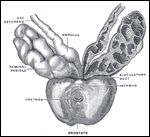New Way to Predict Prostate Cancer Severity-Size of Prostate
It is still difficult to gauge the probability that a low-risk prostate cancer patient may be upgraded to a higher prostate cancer stage. Researchers at Vanderbilt University Medical Center have now determined that smaller prostates were more likely to evolve into more serious, aggressive disease.
It is still difficult to gauge the probability that a patient with low-risk prostate cancer may be upgraded to a higher prostate cancer stage. Upgrading, using the Gleason score after a biopsy, can occur in anywhere from 30% to 50% of prostate cancer cases. Low-risk disease is generally associated with low prostate-specific antigen (PSA) production and a Gleason score of 6 or lower. The Gleason score is a measure of the severity of the prostate cancer assessed using specimens from the initial biopsy.

Prostate with seminal vesicles and seminal ducts, viewed from in front and above; source: Gray's Anatomy
Researchers at Vanderbilt University Medical Center have now determined that prostate size may be a good way to gauge whether a low-risk prostate cancer will upgrade to more aggressive disease. Smaller prostates were more likely to evolve into more serious, aggressive disease. The finding was published in the Journal of Urology.[1]
The severity of disease after surgical removal of the prostate was assessed in 1,251 prostate cancer patients at the Vanderbilt Medical Center who were initially classified as having low-risk disease based on a biopsy. Of these men, 31% had a more severe form of prostate cancer after a final pathology assessment post-surgery. Gleason score upgrading was associated with worse pathological and cancer outcomes. Men with smaller prostates were more likely to have a higher Gleason score after surgery (P = .03). Men with prostate volumes in the 25th percentile were 50% more likely to be upgraded to more aggressive disease.
Isolating low-risk patients who may not need more aggressive treatment is important. The low-risk patients who are truly low-risk with slow-growing disease are candidates for “active surveillance,” or observation without any treatment. But some men with what is evaluated as low-risk disease do progress, and these account for many of the men who end up dying of the disease, the second leading cause of cancer death among men.
It’s still not possible to choose a treatment option based on prostate size, but these findings are a step in the right direction, giving physicians more evidence with which to make a more accurate assessment. Investigators are studying other potential markers to help separate seemingly low-risk patients who actually need more aggressive treatment and surgery from low-risk patients who would not benefit from such aggressive treatment because their disease is not life-threatening.
Larger-scale prospective trials of biomarkers and pathology characteristics are still necessary to identify these two types of patients.
Reference:
1. Davies JD, Aghazadeh MA, Phillips S, et al. Prostate size as a predictor of Gleason score upgrading in patients with low risk prostate cancer. J Urol. 2011;186:2221-2227. Pubmed ID: 22014803